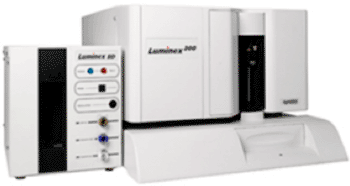Prognostic Tool Predicts Pediatric Septic Shock Mortality Risk
By LabMedica International staff writers
Posted on 25 Feb 2014
A tool has been developed that allows physicians to quickly and accurately predict the risk of death in children with septic shock, a systemic infection that damages vital organs. Posted on 25 Feb 2014
The prognostic tool has been validated and helps doctors decide much faster which severely sick children need to receive aggressive life-saving therapy for septic shock, which is one of the leading causes of death among hospitalized children.

Image: The Luminex100/200 System designed for multiplexing (Photo courtesy of Luminex).
A multi-institutional study led by scientists at the Cincinnati Children's Hospital Medical Center (OH, USA) tested the tool on a group of 182 pediatric patients from the intensive care units of 17 pediatric institutions. The diverse group of study participants from age 1 to 13 years covered a wide range of different conditions and illness severity. All the serum samples from the children were tested within 24 hours of admission to intensive care.
The tool, a pediatric sepsis biomarker risk model is called PERSEVERE. PERSEVERE includes the biomarkers C-C chemokine ligand 3 (CCL3), interleukin 8 (IL8), heat shock protein 70-kDa 1B (HSPA1B), granzyme B (GZMB), and matrix metallopeptidase 8 (MMP8). Serum concentrations of these biomarkers were measured using a multiplex magnetic bead platform (MILLIPLEX MAP) designed for the project by the EMD Millipore Corporation (Billerica, MA, USA). Biomarker concentrations were measured in a Luminex100/200 System (Luminex Corporation, Austin, TX, USA).
The tool showed that children who tested positive for high-risk sepsis had a 34% chance of not surviving, but those children who tested negative had only a 3% chance of dying. The scientists also showed that children who tested positive for high-risk sepsis, but survived the infection, 21% of study patients, had greater degrees of organ failure and longer stays in the intensive care unit. The investigators noted that the treatments received for their sepsis was probably reason these patients survived even though the test showed they were at very high risk.
The authors concluded that they had prospectively tested the prognostic accuracy of the updated version of PERSEVERE and found that it can be used to assign a reliable mortality probability in children with septic shock. This tool has various potential applications in the field of pediatric septic shock. The development of a rapid assay platform to generate biomarker data in a timely manner is still required and although no assay platform currently exists, the technology to develop such an assay is readily available. The study was published on January 29, 2014, in the journal Public Library of Science One.
Related Links:
Cincinnati Children's Hospital Medical Center
EMD Millipore Corporation
Luminex Corporation














